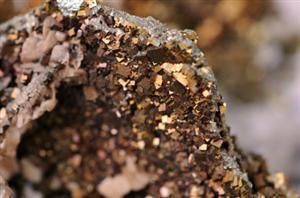| Complexity level: | 9 |
| Project cost ($): | 30 |
| Time required: | It will take an hour to set up the experiment, and an hour to conduct it |
| Material availability: | Access to a chemistry lab required |
| Safety concerns: | Basic safety requirements. |
Hypothesis
More reactive metals will displace the salt compound attached to less reactive metals.
Overview
Displacement in metal
The displacement reaction is a chemical process whereby a compound or salt moves from a less reactive element to a more reactive element. Therefore the more reactive element will be oxidized while the less reactive element is said to be reduced.
As an example, assume that P and Q are different elements and that element P is more reactive than element Q. Let's say that element Q combines with another compound Z, and we call this element QZ. When elements P and QZ combine or mix, compound Z will "move away" from element Q and combine with element P instead, since P is the more reactive element. Therefore element P becomes oxidized and element Q gets reduced.
P + QZ à PZ + Q
The order for the reactivity of metals is as follows:
K > Ba > Ca > Na > Mg > Al > Mn > Zn > Fe > Ni > Sn > Pb > Cu > Ag
The elements on the left side are more reactive and therefore part more readily with their electrons. These elements will also rust or corrode more easily and once they combine with compounds, it is harder to re-extract the element. They act as good reducing agents that serve to removecompounds from other less reactive elements.
Scientific Terms
Materials
The materials required for this science project:
- 6 beakers
- 6 spatulas
- Small metal pieces (at least 6 pieces each) – of copper, magnesium, iron, lead, silver, zinc
- Solution of copper sulfide, magnesium sulfide, iron chloride, lead chloride, silver nitrate and zinc sulfite
- 1 spotting tile
- 6 syringes
- 1 marker pen
Procedure
1. For this science project, the independent variable is the type of metal and compound solution used. The dependent variable is the reaction between the metal and the compound. This is checked by observing for any chemical reaction between the metal and the compound. The constants (control variables) are the size of the metal strips and the concentration of the diluted compounds.
2. The beakers are marked with the names of the solutions - copper sulfide, magnesium sulfide, iron chloride, lead chloride, silver nitrate and zinc sulfite. The solutions are poured into the beakers accordingly.
3. Using the marker pen, the vertical columns of the spotting tile are marked as copper, magnesium, iron, lead, silver and zinc. The horizontal rows of the spotting tile are marked copper sulfide, magnesium sulfide, iron chloride, lead chloride, silver nitrate and zinc sulfite.
4. One metal piece is placed in each depression on the spotting tile according to the metal type marked earlier. For example the column marked copper will have 6 copper plates, one in each depression.
5. The compound solutions are marked along the horizontal rows. Using the syringe, a few drops of the compound solution is placed on the 6 different metal pieces placed in that row. Before taking the next compound solution, either wash the syringe or use another.
6. After all the compounds have been transferred to the spotting tile, observe for any chemical reaction. Mark ‘ Y ’ if there is a chemical reaction. ‘ X ‘ if no chemical reaction and ‘ – ‘ for same element type in the table given below.
Results
The results show that the more reactive metals have more chemical reactions than the less reactive metals.
| Element and substance | Copper | Magnesium | Iron | Lead | Silver | Zinc |
| Copper Sulfide | - | Y | Y | Y | X | Y |
| Magnesium Sulfide | X | - | X | X | X | X |
| Iron Chloride | X | Y | - | X | X | Y |
| Lead Chloride | X | Y | Y | - | X | Y |
| Silver Nitrate | Y | Y | Y | Y | - | Y |
| Zinc Sulfide | X | Y | X | X | X | - |
Conclusion
The hypothesis that a more reactive metal will displace the salt compound attached to a less reactive metal, is proven to be true.
Metal ore contains lots of sand impurities and oxides. Displacement reactions are a useful way of extracting the metal from its ore.
Also consider
This science project can also be repeated using other metals like aluminum, tin, etc.
References
Single displacement reaction - http://en.wikipedia.org/wiki/Single_displacement_reaction
Reactivity series - http://en.wikipedia.org/wiki/Reactivity_series

